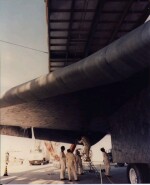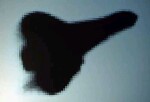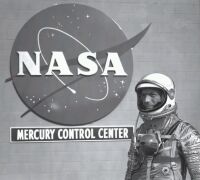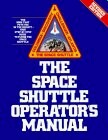|
The Space Shuttle Columbia, flying a mission titled STS-107, broke up while re-entering the Earth's atmosphere on February 1, 2003. Columbia was at an altitude of about 39 miles, and traveling at about 12,500 miles per hour (mach 18.3) when the breakup occurred. Superheated air had entered a hole in the leading edge RCC (reinforced carbon-carbon) caps on the left wing, burning and melting internal structures until the vehicle came apart. All seven crewmembers perished: Commander Rick Husband, Pilot William McCool, Payload Commander Michael Anderson, Mission Specialists David Brown, Kalpana Chawla, & Laurel Clark, and Payload Specialist Ilan Ramon. No Space Shuttle flew again until July, 2005. |
(Aug 9, 2005) The Space Shuttle Discovery was successfully launched on "Return to Flight" mission STS-114 on Tuesday, July 26, and reached orbit without any difficulties. Photo analysis of the Discovery showed that a large piece of spray-on foam insulation again broke off the External Tank during the launch, although there was no indication that it damaged the orbiter vehicle. ET photos showing missing foam - NASA Return to Flight A similar piece of falling insulation has been blamed for putting a hole in the leading edge of the shuttle Columbia's wing in 2003, leading to the destruction of that vehicle and the loss of seven lives on reentry. Discovery landed safely on August 9, 2005. STS-114 was the first Space Shuttle flight since the STS-107 Columbia breakup.
(Feb. 15, 2003) The space shuttle wing leading edge and nose cap are composed of a carbon/carbon composite called reinforced carbon-carbon (RCC). RCC will not melt or decompose at reentry temperatures, but will oxidize at temps above 800° F. (427° C.). To prevent oxidation the RCC is covered with a silicon carbide oxygen-barrier coating. A NASA document from April, 2000 shows that: "Small pinholes roughly 0.1 mm in diameter have been observed on these materials [the silicon carbide, not the RCC] after 12 or more flights. These pinholes have been investigated by researchers... to determine the possible sources and the extent of damage." NASA engineer Dr. Nathan S. Jacobson goes on to say that "Our concern was that if a pinhole went through the silicon carbide to the carbon/carbon substrate, oxygen would have a clear path to oxidize the carbon at high temperatures." Studies of possible damage indicated "a strong dependence on pinhole diameter. For smaller diameters and short times, the oxidation of carbon is very limited." Although NASA officials are no doubt aware of this situation, and some form of impact damage is the leading suspect for causing the Columbia left wing breach, RCC burn-through resulting from pinholes or other damage to the silicon carbide coating should be specifically eliminated as a possibility. 1998 Tech Report: Space Shuttle Pinhole Formation Mechanism Studies, .pdf.  Lockheed Martin photo shows the 22 U-shaped RCC "caps" over a Shuttle wing leading edge.
|
 Columbia's underside shortly before breakup, from a 3½" consumer telescope.
NASA STS-107 Shuttle Mission Archive from NASA's pages with concise but complete descriptions of each of the 100+ Space Shuttle missions thus far, from STS-1, launched on April 12, 1981, right up to the present. KSC STS-107 Shuttle Mission Info STS-51L Challenger: STS-51L Challenger Resources STS-51L Challenger Rogers Commission Report (1986) Personal Observations on the Reliability of the Shuttle is the full text of Richard Feynman's addendum to the STS-51L Challenger Commission report on the catastrophic loss of a Shuttle and seven lives on January 28, 1986. Apollo 13: Apollo 13 Review Board Report (Cortright Commission) 36 .pdf files, also see restored version
| ||||||||||||||||||||||||||||||||||
(Feb. 14, 2003) From a Columbia Accident Investigation Board Statement:
Preliminary analysis: temperatures show the presence of plasma in Columbia's left wheel well during entry (plasma means the super heated gas which surrounds the orbiter during re-entry).
Heat transfer through the structure (as from a missing tile) would not be sufficient to cause the high temperatures seen in the last minutes of flight. An AW&ST story says: "a breach in the left wing-along its leading edge, its landing gear door or seals-would had to have occurred for temperatures in the left wheel well to rise as they did in the final seconds before breakup began, according to data developed by a NASA thermal analysis team...
Sources outside the board noted that it is increasingly likely the breach in the wing structure was not specifically in the wheel well area..." A CNN story quotes a space shuttle program source as saying: "There is no question that wheel well was breached... But who knows how? Did it start there, or was this part of a domino effect?"
The foam ET insulation that broke off during ascent is still a suspect for the cause of such a breach. Another possibility: orbital collision (CNN story).
The board also released a detailed .pdf file showing the ground track of Columbia throughout the reentry, with sensor data from various points along the way.
(Feb. 12, 2003) NASA has released a transcript of voice contact during Columbia's final moments before breakup. They have also released text of email exchanges on the ground during the mission, concerning possible effects on the landing gear door caused by the foam insulation that struck the wing during ascent.
(Feb. 7-11, 2003) A portion of the left wing from the Space Shuttle Columbia has been found near Fort Worth, TX. Debris in this area is the furthest west of any that has been confirmed as coming from Columbia. The "large" wing segment includes leading edge carbon-carbon, and TPS tiles. Space Shuttle program manager Ron Dittemore said: "We have recovered a partial wing leading edge RCC panel, that's reinforced carbon carbon panel. It's 26 to 27 inches long with 18 inches of wing structure still attached." It was later confirmed that the segment is from the left wing. About 12,000 separate pieces of debris had been recovered as of Feb. 10.
Aviation Week & Space Technology magazine reported that the US Air Force was photographing Columbia's descent through a ground-based telescope, and that photos from about 8:59AM ET (1 minute before breakup) show substantial structural damage on the left wing, on the leading edge near the fuselage. In this morning's press briefing, NASA Dep. Assoc. Admin. for ISS & Shuttle Michael Kostelnik confirmed that the photos do exist, but said they are low-resolution and had not yet been evaluated.
The photos were shown at the afternoon press conference, and only a fuzzy-edged shilouette can be seen. Ron Dittemore said: "The nature of the photograph shows some choppiness to the wing leading edge... It is not clear to me that it reveals anything significant at the moment... It does look like there's something just a little different about the left-hand side behind the wing than the right-hand side." It is not likely that any higher-resolution photos of Columbia during reentry exist.
Amateur video taken from Reno, Nevada apparently shows a large fragment breaking off of Columbia as it was in the area of the Arizona-Nevada border. The moon is visible in the video, this + where the video was shot from should allow fairly precise determination of where Columbia was when the piece broke off.
AW&ST says: "The abnormal events seen on orbiter telemetry in Houston indicate a slow penetration of reentry heat into the orbiter and damage on the wing, overpowering the flight control system."
|
Timeline (primarily from the excellent AW&ST article): 7:52 a.m. CST: Abnormal telemetry events began. Columbia was crossing the west coast N. of San Francisco at 43 mi. alt., about Mach 20. At this time Columbia was in a 43° right bank completing its first "roll reversal", an S-turn maneuver to lose speed. That initial bank had been as steep as about 80 deg. between Hawaii and the California coast. This is a normal part of reentry. 7:52 a.m.: 3 left main landing gear brakeline temps show an unusual rise. It appears that hot gases had a flow path within the wing to reach the wheel well. 7:53 a.m.: A 4th left brakeline strut temperature measurement rose significantly--about 30-40 deg. in 5 min. 7:54 a.m.: Columbia was now over E. California-W. Nevada. The left wing root/leading edge area showed an unusual temperature rise of 60° F over 5 min. Something was heating the wing fuselage interface area. Wing leading edge and belly temperatures were over 2,000° F. The outside layer of the double fuselage wall was heating, but the inside wall remained cool. 7:55 a.m.: A 5th left main gear temperature sensor showed an unusual rise. 7:57 a.m.: Columbia was passing over Arizona and New Mexico. The upper and lower left wing temperature sensors failed, probably indicating their lines had been cut. The orbiter was rolling back to the left into about a 75° left bank angle, again to dissipate energy and for navigation and guidance toward Runway 33 at Kennedy, then about 1,800 mi. away. 7:58 a.m.: Still over New Mexico, the elevons began to move to adjust orbiter roll axis trim, indicating an increase in drag on the Columbia's left side of the vehicle. That could indicate a "rough tile or missing tile but we are not sure," Ron Dittemore said. At the same time, the elevons were reacting to increased drag on the left side of the vehicle, the left main landing gear tire pressure and wheel temp measurements failed. This probably indicated a loss of the sensor, not the explosion or failure of the left main gear tires. 7:59 a.m.: Additional elevon motion was commanded by the flight control system to counteract left side drag. The drag was trying to roll the vehicle to the left, while the flight control system was commanding the elevons to roll it back to the right. But the rate of left roll was beginning to overpower the elevons, so the control system fired two 870-lb.-thrust right yaw RCS thrusters to help maintain the proper flight path angle. The firing lasted 1.5 sec. and, along with the tire pressure data and elevon data, would have been noted by the pilots. The USAF telephoto imagery from about this time is said (not yet officially) show substantial damage to the left wing root/leading edge area. 8:00 a.m.: Final contact: CAPCOM Lt. Col. Charles Hobaugh, radioed "Columbia, we see your tire pressure [telemetry] messages and we did not copy your last transmission." On Columbia, CMDR Col. Rick Husband began to reply, "Roger, buh--" and then contact was lost, and the vehicle broke up. Alt.: 207,135 feet (about 39.23 mi.) Speed: Mach 18.3 (about 12,500 mph) Reentry flight director: Leroy Cain |
|
TIME Magazine, February 3, 1967, p. 13: SPACE: "To Strive, To Seek, To Find, And Not To Yield..." Death could have come in any number of bizarre ways. In the explosion of an errant rocket in the view of millions on TV; in the instant incineration of a capsule out of control during the treacherous re-entry into the earth's atmosphere; in the coffin of a malfunctioning craft unable to descend that orbits, orbits, orbits in the spatial void while power ebbs and life leaks away in slow suffocation. But the first three U.S. astronauts to die on duty were motionless and earthbound when they were killed last week. With helmet faceplates closed and suits pressurized, they reclined in a row on padded couches in their cylindrical Apollo capsule, running through the countdown of a simulated launch, a routine but rigorous rehearsal for the real thing. They had been there 5 hrs. 31 min. when fire exploded in the cabin. Within seconds, Lieut. Colonel Virgil Grissom, 40, Lieut. Colonel Edward White, 36, and Lieut. Commander Roger Chaffee, 31, lay dead in the charred cockpit of a vehicle that was built to hit the moon 239,000 miles away, but never got closer than the tip of a Saturn rocket, 218 ft. above Launching Pad 34 at Cape Kennedy... Open-End Mission. As it was planned, the flight of Apollo 204 [today more commonly called Apollo 1, sometimes called Apollo 6] would have tested both the mettle and the technology of the three astronauts beyond anything that men had yet experienced in space. On Feb. 21, the capsule was to be fired off the ground by a Saturn 1-B rocket to go into orbit for as long as Grissom, White and Chaffee could take it, an "open-end" mission that marked a bold departure from the rigidly limited flights of the past. It was to be essentially an engineering flight, a manned shakedown for the Apollo systems, which had already twice been fired aloft without anyone aboard. If things went well, Apollo 204 would lead to two other manned flights later this year, and then, possibly as early as 1968, to fullfillment of man's ancient vision of a landing on the moon. The Apollo, built by North American Aviation, is by far the biggest, most sophisticated space vehicle ever made. It is to the Gemini what a Boeing 747 is to a DC-6-- roomy enough for a man to stand erect amd move about, equipped with space luxuries such as hammock for stretched-out sleeping, hot and cold water, even a toilet... Countdown-Minus-10. At 1 p.m. on Friday last week, Grissom, White and Chaffee strolled casually into the gantry elevator on Pad 34, rose swiftly to a sterilized "white room," then ambled along the 20-ft. catwalk to the stainless-steel hull of the capsule, now secured to the Saturn rocket inside the launching complex. The craft was like an old friend, for they had spent hours in it during vacuum-chamber tests in the Houston Space Center, had run through identical launch-simulation procedures several times before. All spacecraft have their own personal quirks, and 204 had been balky from the start... The nozzle of its big engine shattered during one test. The heat shield of the command module split wide open and the ship sank like a stone when it was dropped at high speed into a water tank. Certain kinds of fuel caused ruptures in attitude-control fuel tanks. The cooling system failed, causing a two-month delay for redesign. But all the bugs were eventually ironed out, as far as the experts knew, after arduous testing under every conceivable circumstance. Last week's test was billed as the ship's first full "plugs-out" operation-- meaning that the craft was to rely solely on its own power system instead of using an exterior source... At 2:50 p.m., the airtight double hatch plates were sealed. And the familiar routine began, an infinitely detailed run-through that was scheduled to last slightly more than five hours. Things progressed smoothly enough; a few "glitches" (minor problems) stalled the operation. At countdown-minus-10-minutes, the procedure was stopped again because of static in the communications channels between the spacecraft and technicians at the operations center. It took 15 minutes to correct the problem, and the simulated count was ready to begin again. Then, at 6:31 p.m., a voice cried from inside the capsule: "Fire aboard the spacecraft!" No Random Failure. At the same instant, a couple of technicians standing on a level with the craft windows saw a blinding flash inside the ship. Heavy smoke began to seep from the capsule, filling the white room. A workman sprinted across the catwalk leading to the craft, tried desperately to loosen the hatch cover. He was driven back by the intense heat and smoke, but half a dozen other technicians, some wearing face masks and asbestos gloves, raced to help. One or two would try to wrench open the hatch, then fall bach again from the scorching heat while others struggled with it. Six minutes after the cry of alarm, the hatch sprung open. A blast of hot air shot out, followed by suffocating clouds of smoke. The rest was silence. The flames were apparently sucked into the astronauts space suits, killing them as soon as they noticed the fire. The three charred bodies were left strapped to their couches for more than seven hours while anguished experts sought to piece together the reasons for the accident... |
This page's URL is: //scitech.quickfound.net/astro/space_shuttle_columbia_sts-107.html

